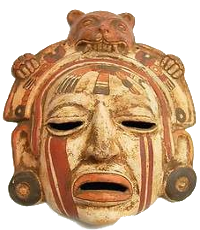Big heads of the Olmecs
[espro-slider id=1667]
The Olmecs was the first major kingdom to emerge in Mexico, some 1800 BCE. The center of their society was the basin of the Coatzacoalcos river in the tropical lowlands of southern Mexico. That is, it was a state similar to, and appearing at the same time as, the far more famous states of Mesopotamia, the Nile and the Indus. The Olmecs lived in cities, they built pyramids, carried out human sacrifices and engaged in ritual bloodletting. [Read more: “Royal bloodletting ceremonies“] But they also invented a system of writing, created a calendar with 365 days in a year, and recorded their histories in books made of fig tree bark. They were the first to play games with large balls made of rubber. The many achievements of the Olmecs were built on by all Central American societies that came after them, including the Maya and the Aztecs.
What they also created, and what they are known for today, is their artwork. Using jade, clay, basalt and greenstone, they made figurines of remarkable expressiveness and individuality. Often they show babies with chubby bodies, jowly faces, down-turned mouths and puffy eyes. The babies have holes in their earlobes and probably wore earrings at one time. They may also have worn clothes. Why babies were depicted and which role the figurines played in Olmec society we do not know.
Yet the most famous Olmec artworks are the colossal heads they created in stone. Many of these statues are more than two meters tall, and the tallest is 3.4 meters, weighing an estimated 50 tons. We do not know who these people were – kings perhaps, but judging by the helmet-like headgear they are wearing, they may also have been famous ball-players. [Read more: “Juego de pelota“] The stone used for the statues has been transported from far away. How this was done in a society which had no beasts of burden and no carts with wheels is difficult to explain. There are 17 of these gigantic heads in existence today, all in Mexico, while the Olmec figurines can be found at museums around the world. Some have decided that the colossal heads have African features and argued that this proves that the Olmecs were settlers from Africa. No serious scholar of ancient Mexico holds this view.
External links:
- Claude-François Baudez, “Beauty and ugliness in Olmec monumental sculpture”
- Ivan van Sertima, “They came before Columbus: the African presence in ancient America”
- La Venta, Complex A. Olmec Archaeological Ruins
- Olmec Colossal Heads
- Real History, “The Olmec and the Americas”
- ThoughtCo, “The Olmec City of San Lorenzo”
- Vintage News, “Mexico’s ‘Olmec Colossal Heads’ are a mystery as to their age and their method of construction”
